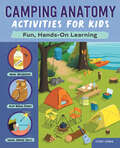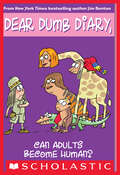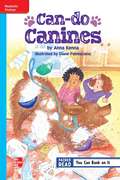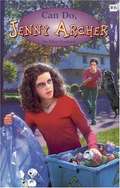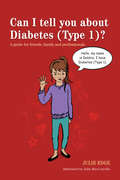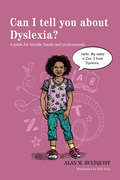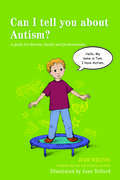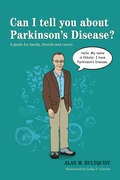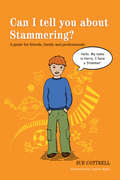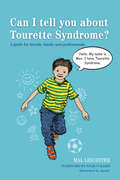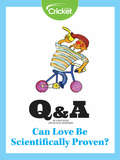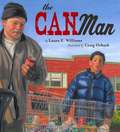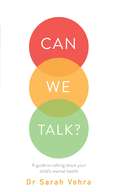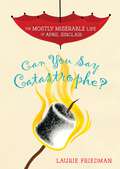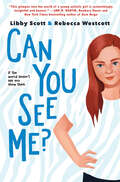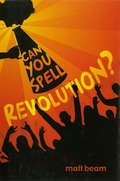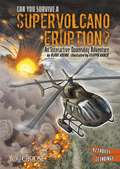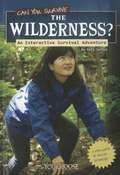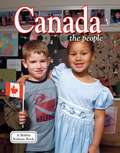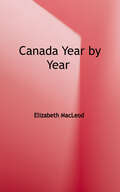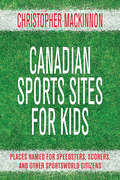- Table View
- List View
Camping Anatomy Activities for Kids: Fun, Hands-On Learning (Anatomy Activities for Kids)
by Steve LemigExplore like a scientist with this illustrated camping guide for kids ages 8 to 12Camping is the perfect time to learn about the world around you. Adventure through nature like a real scientist with Camping Anatomy Activities for Kids. It's full of super-fun activities and lessons that show you how to build a working campsite, stay safe on the trail, and much more! You'll learn new camping skills and keep track of everything you discover as you become an outdoor lover for life.Go beyond other camping books for kids and:Experience the wilderness—20 unique lessons teach you how to ask questions about the natural world, imagine solutions to potential problems, and test ideas to prepare for a successful camping trip.Try awesome activities—Get your campsite up and running with activities like pitching a tent, reading the stars, and drawing a map.Start a camping journal—Use your own blank journal to answer writing prompts that help you record your ideas and observations.Become an expert camper as you interact with the outdoors through this nature journal for kids.
Can Adults Become Human? (Dear Dumb Diary #5)
by Jim BentonRead the hilarious, candid (and sometimes not-so-nice), diaries of Jamie Kelly, who promises that everything in her diary is true...or at least as true as it needs to be.Dear Dumb Diary,My social studies teacher, Mr. VanDoy, never smiles. I know that's hard to believe, because everybody smiles about something, right?Isabella smiles when her brothers get in trouble. Angeline smiles when she thinks about how much prettier she is than, like, a waterfall or a unicorn. I smile when I think about a unicorn kicking Angeline over a waterfall. But Mr. VanDoy doesn't smile at all. I wonder if when you become an adult, you can lose your sense of humor the way you lose your teeth or hair or fashion sense.
Can Do, Jenny Archer
by Ellen ConfordIn attempting to win a can-collecting contest, the winner of which will direct a class movie, Jenny risks losing her best friend.
Can I tell you about Diabetes (Type 1)?: A guide for friends, family and professionals
by Julie Edge Julia MacconvilleMeet Debbie - a young girl with diabetes type 1. Debbie invites readers to learn about this type of diabetes from her perspective, describing how it feels to have high and low blood sugar levels. She explains how she can monitor her blood sugar and controls it with medication. Debbie also talks about the challenges of having diabetes and lets readers know how she can be helped and supported. This illustrated book is ideal for young people aged 7 upwards, as well as parents, friends, teachers and nurses. It is also an excellent starting point for family and classroom discussions.
Can I tell you about Dyslexia?: A guide for friends, family and professionals
by Bill Tulp Alan M. HultquistMeet Zoe - a young girl with dyslexia. Zoe invites readers to learn about dyslexia from her perspective. She helps readers to understand the challenges faced by a child with dyslexia, explaining what dyslexia is and how it affects her at home and at school. Zoe describes exactly why she finds reading, writing and words so difficult, and how other people can help her in these areas. This illustrated book is ideally suited for readers aged 7 and upwards, and will be an excellent way to start a discussion about dyslexia, in the classroom or at home.
Can I tell you about Dyspraxia?: A guide for friends, family and professionals
by Maureen Boon Imogen HallamMeet Marco - a boy with dyspraxia, which is sometimes called Developmental Co-ordination Disorder (DCD). Marco invites readers to learn about dyspraxia from his perspective, helping them to understand what it is and what it feels like when he sometimes struggles to control his movement and co-ordination. He talks about the challenges of having dyspraxia and lets readers know how he can be helped and supported. This illustrated book will be an ideal introduction for young people, aged 7 upwards, as well as parents, friends, teachers and professionals working with children with dyspraxia. It is also an excellent starting point for family and classroom discussions.
Can I tell you about Parkinson's Disease?: A guide for family, friends and carers
by Lydia Corrow Alan M. HultquistMeet Nikolai - a man with Parkinson's disease. Nikolai invites readers to learn about Parkinson's from his perspective, helping them to understand how Parkinson's affects his daily life and why some tasks can be especially challenging for him. He also gives advice on how to help someone with Parkinson's when they have difficulties with physical movements and memory. This illustrated book is full of useful information and will be an ideal introduction for children from the age of 7, as well as older readers. It will help family, friends and carers better understand and explain the condition, and will be an excellent starting point for group discussions.
Can I tell you about Stammering?: A guide for friends, family and professionals
by Sue Cottrell Sophie KhanMeet Harry - a young boy who stammers. Harry invites readers to learn about what it is like to stammer from his perspective and how it affects his daily life and makes him feel. He talks about techniques that can help reduce stammering and describes how friends, family and others can help him to feel at ease and reduce his stammer further. This illustrated book is full of useful information and will be an ideal introduction for young people, aged 7 upwards, as well as parents, friends, teachers and speech therapists working with children who stammer. It is also an excellent starting point for group discussions at home or school.
Can I tell you about Tourette Syndrome?: A guide for friends, family and professionals
by Julie Collier Apsley Mal LeicesterMeet Max - a boy with Tourette syndrome (TS). Max invites readers to learn about Tourette's from his perspective, helping them to understand what tics and triggers are and what it feels like to have TS. He explains how living with TS can sometimes be difficult, and how people around him can help him to feel happy and accepted. This illustrated book is ideal for young people aged 7 upwards, as well as parents, friends, teachers and other professionals working with children with TS. It is also an excellent starting point for family and classroom discussions.
Can Love Be Scientifically Proven?
by Lizzie WadeIs there a scientific explanation behind falling in love? Learn the answers from scientists who look into the physiology of romance.
The Can Man
by Laura E. Williams Craig OrbackTim's birthday is just a week away, and more than anything he wants a skateboard. But money is tight, and Tim knows his family cannot afford to buy him a board.<P> As Tim ponders how he might earn money for a skateboard, he hears The Can Man down the street collecting empty soft drink cans. The clang of the cans in the homeless man's cart gives Tim an idea. He will collect cans too, and cash them in for the redemption money. By the end of the week, Tim has almost reached his goal--until a couple of chance encounters with The Can Man change everything.<P> Told with honesty and respect, this timely story shines a perceptive light on current social concerns. Readers will be encouraged to think beyond themselves and celebrate the simple acts of kindness and sharing that make a difference in people's lives.
Can We Talk?: About Mental Health in Children and Young People
by Sarah Vohra'Parental anxiety is natural, but if you think something's wrong - trust your instincts. Talk to your child and seek professional help sooner, rather than later'. - Dr Sarah VohraHow do you know what to worry about - and what not to worry about?How do you keep the lines of communication open?When - and how - should you seek professional help?In Can We Talk? consultant child psychiatrist Dr Sarah Vohra shares an easy-to-use traffic light system that will help you to navigate tricky early conversations. Whether your child is 6 or 16, the expert advice and practical tools in this book cover such key concerns as sleep, low mood, anxiety and self-harm. This updated edition also includes a new chapter on the impact of social media on your child's wellbeing, with strategies to help you support them in a world where Instagram and Snapchat multiply the pressure to be perfect at all levels and all times.Whether your child is a preschooler or a teenager, this is an invaluable resource for anyone worried about a young person's mental health.
Can You Say Catastrophe? (The Mostly Miserable Life of April Sinclair #1)
by Laurie FriedmanApril Sinclair just wants what any normal thirteen-year-old would want: to disown her parents and obnoxious little sisters; to escape to summer camp ASAP with her two best friends, Billy and Brynn; and to make a good impression on Matt Parker, the hot new boy next door. Unfortunately, Matt witnesses April's utter humiliation at her birthday party. Then Billy kisses her. Just as April is trying to figure things out, her parents cancel her camp plans in lieu of a family RV trip. A summer of babysitting her sisters and "re-bonding" with her family isn't how she imagined life as a teenager. And it certainly won’t help her straighten out her feelings about Billy or Matt. Is there any silver lining to a road trip in The Clunker with her family of misfits?
Can You See Me?
by Rebecca Westcott Libby ScottTally is eleven years old and she's just like her friends. Well, sometimes she is. If she tries really hard to be. Because there's something that makes Tally not the same as her friends. Something she can't cover up, no matter how hard she tries: Tally is autistic. <p><p> Tally's autism means there are things that bother her even though she wishes they didn't. It means that some people misunderstand, her and feel frustrated by her. <p><p> People think that because Tally's autistic, she doesn'trealise what they're thinking, but Tally sees and hears - and notices - all of it. And, honestly? That's not the easiest thing to live with. <p><p> Perfect for fans of Wonder and The Goldfish Boy, this sucker punch to the heart is valuable reading for children and adults alike.
Can You Spell Revolution?
by Matt BeamBetween dull assemblies, tyrant teachers, and a handbook full of rules, life at Laverton Middle School can be summed up in one word: B-O-R-I-N-G. In this dramatic novel, five fed-up students borrow from the pages of history books and, seeking inspiration from revolutionary leaders, get a twisty lesson in the excitement and perils of repeating history.
Can You Survive A Supervolcano Eruption?: An Interactive Doomsday Adventure (You Choose: Doomsday Ser.)
by Blake Hoena Filippo VanzoA supervolcano has erupted! Its eruption is thousands of times larger than a normal volcano. Huge amounts of lava and ash threaten all life in the area. You're a visitor to the park when the eruption occurs. Will you stay to monitor the volcano, or evacuate to safety? When YOU CHOOSE what to do next, the choices you make could mean the difference between life and death. Can you survive a supervolcano?
Can You Survive The Wilderness?: An Interactive Survival Adventure (You Choose: Survival Ser.)
by Matt Doeden Chris LaliberteThe wilderness is a place of beauty and peace. But it is also filled with fierce predators, poisonous plants, and raging rivers. Will you: Try to survive the harsh mountains of Alaska after being abandoned during an outdoor training trip? Struggle to make your way out of the deep forests after becoming lost in Australia’s Blue Mountains? Attempt to find help for your injured brother in Washington’s Cascade Mountains?
Canada: The people (The Lands, Peoples, and Cultures Series)
by Bobbie KalmanUpdated facts and statistics support this fascinating portrayal of a nation built on immigration. Important issues that must be resolved with the Native peoples are sensitively portrayed.
Canada
by Elaine LandauIdeal for today's young investigative reader, each A True Book includes lively sidebars, a glossary and index, plus a comprehensive "To Find Out More" section listing books, organizations, and Internet sites. A staple of library collections since the 1950s, the new A True Book series is the definitive nonfiction series for elementary school readers.
Canada and Latin America
by Michael J. Berson Tyrone C. Howard Cinthia SalinasNIMAC-sourced textbook
Canada Year by Year
by Elizabeth MacLeodThis fascinating history highlights a single milestone for every year from the country's founding in 1867 up to its 150th anniversary in 2017. Divided into ten distinct eras, coverage ranges from politics, sports, business and arts and culture, and includes significant events both at home and in world affairs. A few examples: 1881 A railway across Canada is begun. 1893 The Stanley Cup is first awarded in hockey. 1908 Lucy Maud Montgomery's Anne of Green Gables is published. 1947 Oil is discovered in Alberta. 2015 Liberal Party leader Justin Trudeau is elected prime minister. Along with the featured stories for each of the 150 years, the pages are filled with sidebars with content such as short biographies, quotes, important firsts and trivia that are linked to that year. There are also 39 capsule biographies of noteworthy Canadians at the back of the book. The topics chosen offer an inclusive historical perspective, incorporating women, Aboriginal peoples and people with disabilities into Canada's rich and diverse narrative. Illustrations by awarding-winning artist Sydney Smith bring a contemporary feel to the stories of the past. This book is a perfect fit for lessons on Canadian history and geography. The accessible format also makes it a compelling choice for children to pick up and browse, or to search for a particular year. A table of contents and an index round out this engaging reference.
Canadian Sports Sites for Kids: Places Named for Speedsters, Scorers, and Other Sportsworld Citizens
by Christopher MackinnonEverything you need to know about Canadian places named after our sports stars. In Canada, sports aren’t just entertainment; they’re literally part of the landscape. We’ve named everything from parks and streets to schools and stadiums after some of our favourite pro athletes and sports figures past and present. Wayne Gretzky Drive, Mike Weir Park, Roberto Luongo Arena, the Cindy Klassen Centre, Justin Morneau Field — Canadian Sports Sites for Kids is your entertaining, map-filled guidebook to hundreds of these special locations. The fast-paced stories, maps, and lists highlight everything you need to know about Canada’s sports geography.Plus, explore other little-known sites of interest, such as: • The Canadian city that named a park after an arm-wrestling promoter • The Ontario town that honoured a hockey fan with a place name • The Prince Edward Island village where the biggest street is named for the writer of "The Hockey Song" • The whereabouts of Canada’s only street named for a boxing champ
